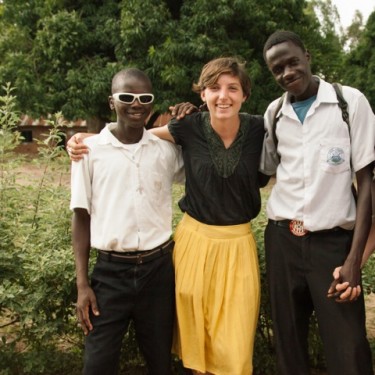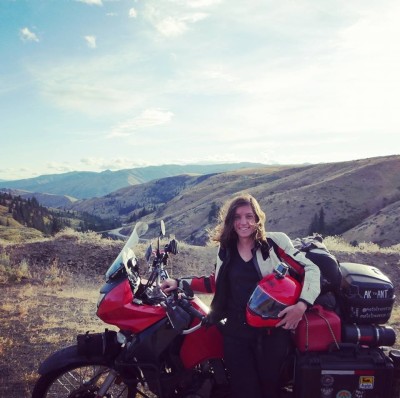About the author: In 2016, Kate Murray stepped away from her position as lead maker educator at Space 8, an educational makerspace designed for 8- to 12-year-olds, to embark on a motorcycle journey from Alaska to Antartica. Maker Ed has been keeping up with Kate throughout her trip as she connects with maker educators and makerspaces around the world, and we are thrilled to present her story in this brand new two-part series.
In Part I, Kate explores her own maker origins and the path that led to her incredible makerspace road trip. Next week, in Part II, she will examine some of the lessons, challenges, and potential solutions faced by maker educators across the globe.
Part I
In the small village of Awach, in northwestern Uganda, stands a beautiful mango tree. Twice a year, as the rainy season’s offerings soak down to its roots in the sandy red soil, it manages to produce tremendous amounts of fruit, varying in shades of green and fading to orange-red. All year, its leaves produce a thick, cool shade. It was under this tree that a circle of chatty teachers and students gathered to discuss all varieties of topics connected to education and its impact. It was beneath this canopy that I spent many afternoons sipping tea, eating boiled cassava root, and peeling mangoes while learning what it truly meant to be a part of a community.
 On all sides of the tree stands Awach Secondary School, where, three times a week, I served as a supplementary English teacher for a class of over sixty students in a classroom equipped only with shared wooden desks and a chalkboard. It was a position I was, in all respects, not wholly prepared for, particularly because I lacked the intimate, personal awareness of the obstacles faced by the students. Despite the challenges facing them, I witnessed the eagerness of so many students to excel past these obstacles and complete a basic education.
On all sides of the tree stands Awach Secondary School, where, three times a week, I served as a supplementary English teacher for a class of over sixty students in a classroom equipped only with shared wooden desks and a chalkboard. It was a position I was, in all respects, not wholly prepared for, particularly because I lacked the intimate, personal awareness of the obstacles faced by the students. Despite the challenges facing them, I witnessed the eagerness of so many students to excel past these obstacles and complete a basic education.
These students revealed to me the depth of privilege I was afforded by my own education, and brought light to the many significant ways in which I, an educator, must adjust to the learner. And though I did not realize it at the time, it was with these students that I had my first experiences as a maker educator.
At the beginning, most days in the classroom felt like a flop. My American accent challenged them in beneficial ways, my goofy attempts to define certain words between two languages made them laugh, but for the most part the information I conveyed lacked the kind of critical response I felt was indicative of the most valuable kind of learning. But on one particular day, I was desperate to explain the concept of tone in writing, and how it might affect the message conveyed. Having exhausted my more theatrical attempts, I brought in a large stack of local newspapers, a handful of scissors, and one bottle of glue.
The students, used to following scripts in the classroom and reflecting standards of success defined well outside of themselves, gave me skeptical looks as I asked them to scour the newspapers for words,headlines, and phrases that evoked feelings, cut them out, and determine a tone word that corresponded to their selections. Cynical, formal, joyful… all these words began to take shape. I sat among small groups, moved throughout the classroom, and watched the room come alive in a way that I previously thought impossible.
I knew something special had happened in that classroom. The excited, collaborative engagement of the students was reminiscent of the critical thinking I witnessed in their weekly debate club meetings, and of the joy they expressed during Music, Dance & Drama sessions. It reminded me too of the driven student who approached me after class one day with questions of how he might harness the wind and build contraptions to bring electricity to the computers gathering dust in Awach’s storage. I had no familiarity with “making,” the culture behind it, or how it might apply to education, but each of these interactions revealed to me the particular power of integrating hands-on, student-led activities into education and led me to thoroughly consider whether I would pursue teaching as a profession when I left Awach.
It was those very memories which came to mind when I returned to the States and became a lead educator in Space 8, an educational makerspace designed for 8-12 year olds. Though I had been making, crafting, and tinkering my whole life, it was in this space that I came to know the term “maker” and the many benefits of maker education. As is described so perfectly by Maker Ed in this video, “maker education allows us to move towards a more comprehensive educational approach that better reflects and incorporates the diverse, complex, and ever-changing nature of our world.” It emphasizes empowerment, access, process, and community.
In the makerspace, I was not only empowered to engage with science and math, subjects I had always found so inaccessible, but also fostered the journeys of many young learners into S.T.E.A.M. subjects they themselves saw as distant or difficult. Alongside many kids and with tools in hand, I learned what it is to be a creative problem solver. I learned that the skepticism and subsequent responses I saw in Awach are not particular to Ugandan classrooms. To bring making into education—regardless of subject—diverts this path, empowers the learner, engages their creativity, and allows them to define their own success.
 With a heavy heart, I left this space, my home, and my family in June of 2016 to travel from Alaska to Antarctica on a motorcycle… But I did not want my journey in maker education to end. I reached out to Maker Ed for some leads on great people and projects in the field. Positive responses flew into my inbox—and led to even more contacts. My map became scattered with makers and moments yet to be had.
With a heavy heart, I left this space, my home, and my family in June of 2016 to travel from Alaska to Antarctica on a motorcycle… But I did not want my journey in maker education to end. I reached out to Maker Ed for some leads on great people and projects in the field. Positive responses flew into my inbox—and led to even more contacts. My map became scattered with makers and moments yet to be had.
[iframe src=”https://www.google.com/maps/d/u/1/embed?mid=1_Zr2aQsyR6W7hvMSNHu5_jM-8dA” width=”100%” height=”480″]
Click on the map pins for more information about each makerspace site!
Just as I found community while sitting in the cool shade of the mango tree, I have found, dotted along this map, numerous communities budding, all committed to creating engaging learning experiences through making. As I made my way from country to country, and community to community, it became clear that in growing and adapting to the input, perspectives and voices of the individuals they serve, maker educators across the world are facing similar challenges. It has been incredible to see the many ways in which these educators take on these questions and challenges, and take an active stance in forming the future of education.
Are you ready to take that stance yourself?
Stay tuned—next week, Kate will explore the many lessons she learned from maker educators across two continents, and how these might guide you on your own maker educator journey.
